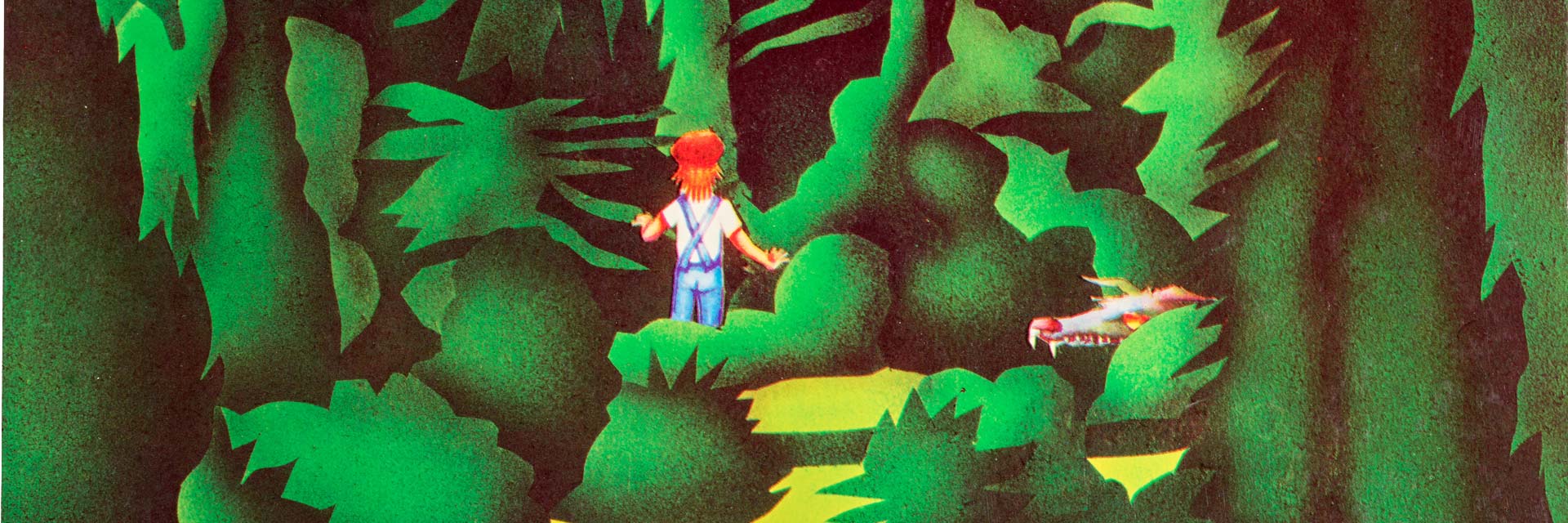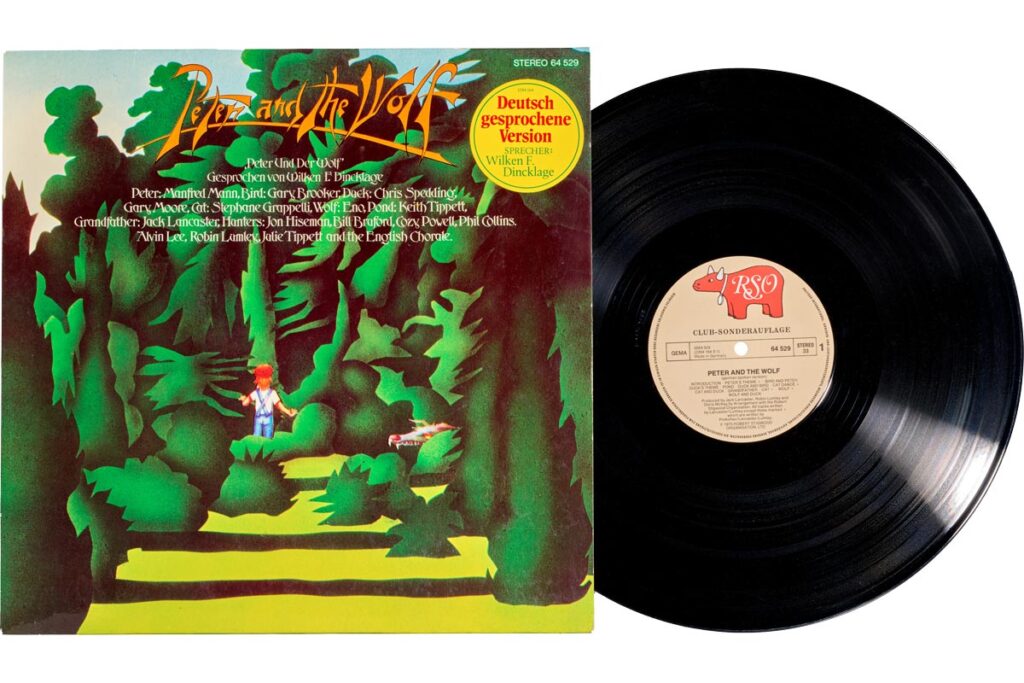In the 1970s, rock versions of classical music weren’t considered cringe yet.
Emerson Lake & Palmer rocked Mussorgsky’s Pictures at an Exhibition, Beggars Opera adapted overtures by Suppè, Ekseption played the first movement of Beethoven’s Fifth and Deep Purple the Allegretto from Beethoven’s Seventh. Such arrangements built important bridges between genres, social milieus and generations. They helped rock music achieve wider recognition and gave young audiences their first access to classical music.
The British musicians Jack Lancaster (saxophone) and Robin Lumley (keyboards) worked well as a team. In 1974, the two were commissioned to produce a modern soundtrack for a planned film adaptation of Prokofiev’s musical fairy tale Peter And The Wolf. When the film project fell through, it didn’t sadden them too much, as they now had free rein with the music. “For me, the album was the most important part of the project anyway,” said Lancaster. The RSO label (which was to become rich a few years later with the Bee Gees’ disco hits) supported the two of them unconditionally. The budget allowed a who’s who of London’s progressive rock scene to come together at Trident Studios – musicians from bands such as Colosseum, Genesis, King Crimson, Procol Harum, Ten Years After, Thin Lizzy and Yes. “We chose all the participants very carefully” (Lancaster).
Lancaster and Lumley only used the most suitable of Prokofiev’s musical themes. Pete Haywood plays the “Peter” theme on the steel guitar, Stéphane Grappelli improvises on the “Cat” theme on the violin, Brian Eno lets the “Wolf” theme growl menacingly on the synthesizer. Gary Moore portrays the quacking “duck” on the wah-wah guitar – but Prokofiev’s “duck” motif is only heard in the last wah-wah piece (“Duck Escape”). Two thirds of the tracks do without Prokofiev’s themes altogether: “The new pieces were developed in the recording studio,” revealed Lancaster. “A lot of it was down to the improvisational talent of the musicians involved.”
The core band on the album is the jazz rock quartet Brand X, which was to make its debut album shortly afterwards (in the fall of 1975). The most prominent member of Brand X was Phil Collins, the drummer from Genesis. Because Collins’ regular band was “on the ropes” after the departure of Peter Gabriel, he had time to get involved with Brand X. There are many Genesis moments in the grooves on Peter And The Wolf.
Jack Lancaster & Robin Lumley – Peter And The Wolf
Recorded: 1975
Published: 1975
Label: RSO
Produced by: Lancaster, Lumley, Mackay
Tracklisting
A
- Introduction 1:05
- Peter’s Theme 2:10
- Bird And Peter 0:38
- Duck Theme 1:00
- Pond 0:46
- Duck And Bird 2:11
- Cat Dance 2:37
- Cat And Duck 1:32
- Grandfather 3:04
- Cat 0:34
- Wolf 0:46
- Wolf And Duck 3:46
B
- Threnody For A Duck 1:51
- Wolf Stalks 0:57
- Cat In A Tree 2:13
- Peter’s Chase 1:45
- Capture Of Wolf 1:27
- Hunters 0.58
- Rock And Roll Celebration 2:38
- Duck Escape 1:11
- Final Theme 5:07
Musicians
Jack Lancaster – Holzblasinstrumente, Violine
Robin Lumley – Keyboards
John Goodsall – Gitarre
Percy Jones – Bass
Phil Collins – Schlagzeug, Vibrafon, Percussion
&
Gary Brooker, Bill Bruford, Brian Eno, Stéphane Grappelli, Jon Hiseman, Alvin Lee, Manfred Mann, Gary Moore, Cozy Powell, Chris Spedding, Julie Tippett, Keith Tippett u. a.
Commentary and Trivia
- The album is one of the most successful rock adaptations of classical music – elegant, sophisticated, multi-faceted, virtuosic and independent. “A lively, colorful spectacle” (Malcolm Dome)
- The musical palette is vast: it ranges from country, blues and soul to prog rock, jazz rock, funk, swing and free jazz. Although four star drummers are involved, there are also many pieces without any drums at all.
- Prokofiev wrote his musical fairy tale Peter and the Wolf in 1936 on his return to the Soviet Union. It was commissioned by the Moscow Children’s Theater – the composer wrote the narrative text himself. At the time, Prokofiev declared his work to be a parable about the victory of socialism (Peter) over fascism (the wolf).
- The dynamics reach their climax when the cat and duck quarrel (“Cat And Duck”) or when the wolf chases the duck (“Wolf And Duck”). There are wild jams in both pieces: Henry Lowther vs. Gary Moore – or Brian Eno vs. Chris Spedding.
- The funeral choir for the duck (“Threnody”), the musical representation of the pond with piano, vibraphone and chimes (“Pond”) and the marching parade of the hunters with four drummers and several horns (“Hunters”) offer some special moments.
- The jazz violinist Stéphane Grappelli (1908-1997) is an unexpected player. He makes the “cat” swing (“Cat Dance”, “Cat”) and also dedicates a free solo improvisation to it (“Cat In A Tree”). His participation was Jack Lancaster’s wish: “Grappelli had an enormous influence on me. The violin was my first instrument.” In other “feline” passages, Lancaster himself or Henry Lowther take on the violin part.
- The narrator between the pieces is the singer Viv Stanshall (1943-1995), also known as the “Announcer” on Mike Oldfield’s Tubular Bells. Further versions in four languages were created for the international market. The German version is spoken by presenter and singer Wilken F. Dincklage (Rentnerband, Otto films).
- The record cover and the twelve-page booklet (in the style of a children’s picture book) reveal taste. A later new edition under the title The Rock Peter And The Wolf uses different artwork.
- The album’s only weak moment comes at the end. The “Final Theme” contains an overly anthemic, soulful song of praise (“Peter is a hero, Peter is a brave one”).
Find Peter And The Wolf by Jack Lancaster and Robin Lumley at discogs.com


